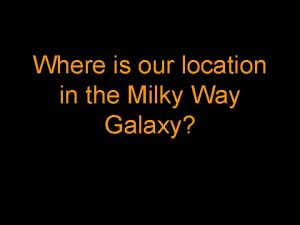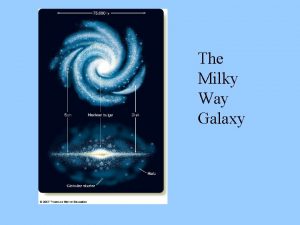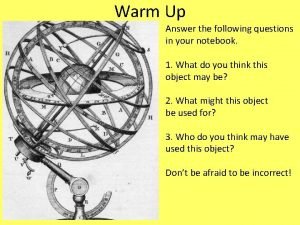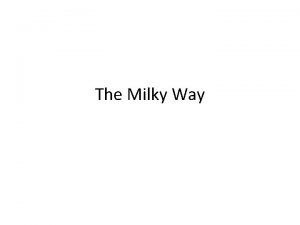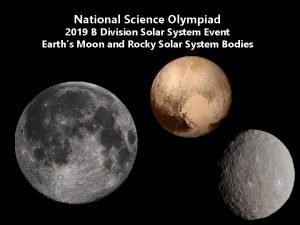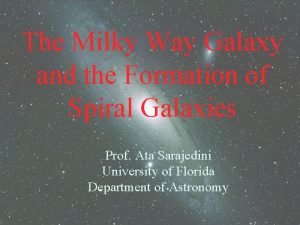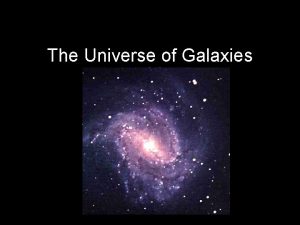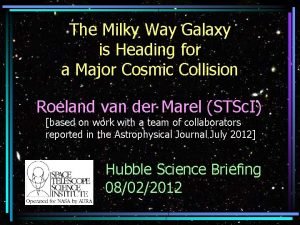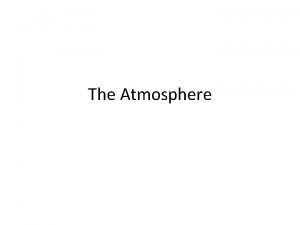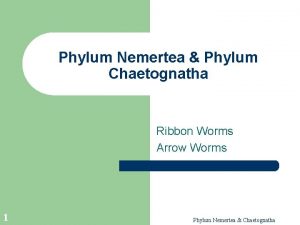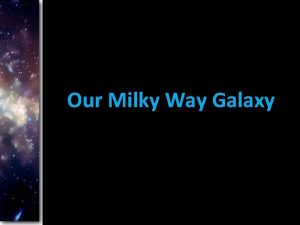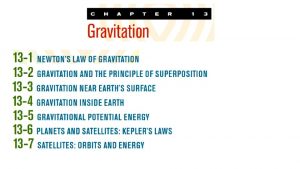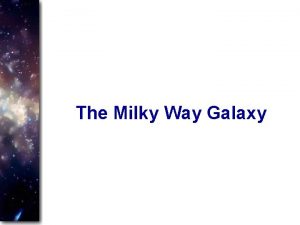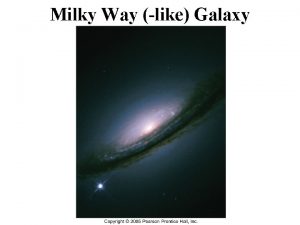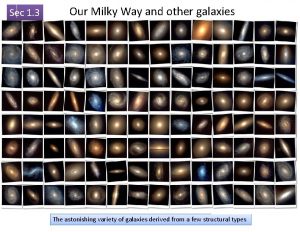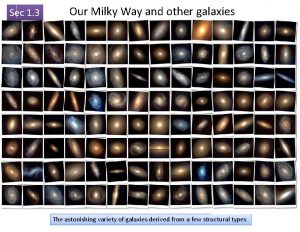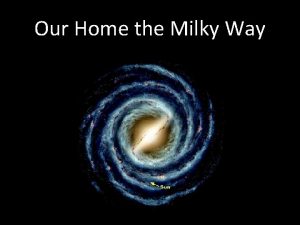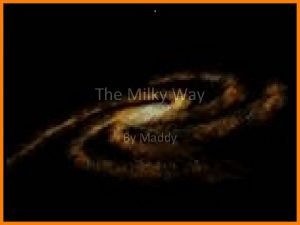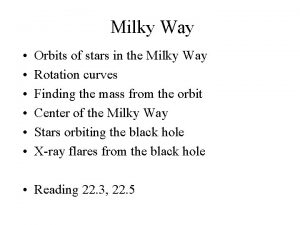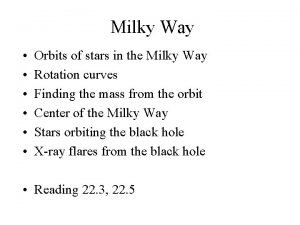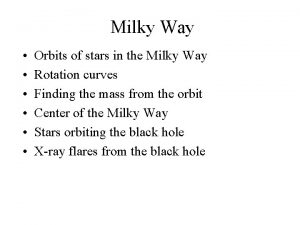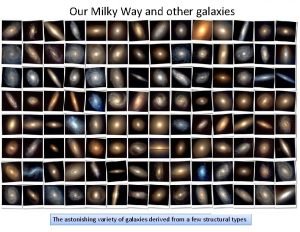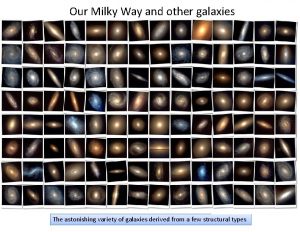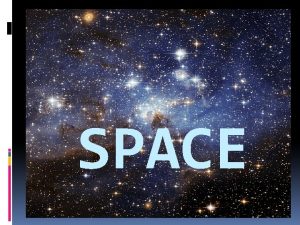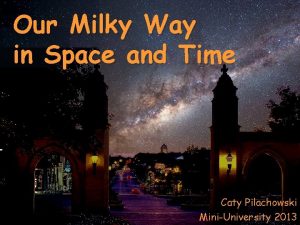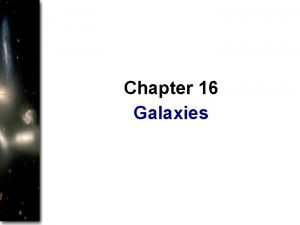Sec 1 3 Our Milky Way and other




















- Slides: 20

Sec 1. 3 Our Milky Way and other galaxies The astonishing variety of galaxies derived from a few structural types

Edwin Hubble The Realm of the Nebulae (1936) ‘Tuning Fork’ classification scheme of galaxies Jargon still in vogue today! Early Type Unbarred Spirals Lenticulars Late Type Barred Spirals Hubble’s (early) view of galaxy evolution Classification of ellipticals, En, based on ellipticity, e = (1 – b/a) Shows visual Prone to projection effects flattening Irregulars = misfits in any class

The current classification scheme of galaxies (includes dwarfs, irregulars, etc. ) Unbarred Spirals Lenticulars Barred Spirals Current view of hierarchical galaxy formation and evolution (Lambda-CDM model) See Conselice (2014) ARAA review article on galaxy structure and evolution (on Course Spaces)

Current classification scheme of galaxies Further recent additions: Ultra-faint, compact dwarf galaxies Read S&G Sec 1. 3 for descriptions of acronyms, as well as details regarding various classes and subclasses. Also books on reserve at the library.

Further details in S&G Sec 1. 3 General characteristics of Ellipticals § Ellipticals derive their name from their general shape, 3 D ellipsoids (En) § Light distribution follows de. Vaucouleur’s r 1/4 or Sersic (n >= 4) profiles § Smooth, no obvious morphological features (e. g. spiral arms) § Little or no content of cool gas (molecular hydrogen) and dust § No or very low trace of ongoing star formation (no O/B stars) § Old evolved stellar population (G, K giants) § Generally red in photometric colors § Populate high density regions, e. g. galaxy clusters (‘Red Sequence’) § The most massive ellipticals are called c. D § Dynamical signature shows random motions of stars, little or no ordered circular motion (low mass E’s may have disk-like structure) § Galaxies are ‘pressure’ supported (like gas particles in a container) § Low mass ellipticals show some rotational support § Extremely high M/L in dwarf ellipticals (d. E) and dwarf spheroids (d. Sph)

Further details in S&G Sec 1. 3 General characteristics of Spirals § Spiral galaxies named for their distinctive spiral arms embedded is a thin, circular disk-like structure § Most have a spheroidal central component, called the ‘bulge’ § Light distribution in the disk follows an exponential profile, while the bulge light is similar to that of an elliptical (r 1/4) § Stars in the disk show ordered circular motion (rotation support), while bulge stars show mainly random motion (pressure support) § Disks are rich in molecular gas, with active star formation in star clusters along the spiral arms (O/B associations); bulges are poor in gas, low SF (near nucleus) § Disks are blue in photometric colors (young stellar population), while the bulge contains old, evolved stellar population (red color) § About 50% of spirals have central ‘bar’ like structure (due to disk instability, though origin and lifetime are not fully understood) § Sa to Sd – spiral arms more open, bulge less distinct, more gas and SF

Further details in S&G Sec 1. 3 General characteristics of Lenticulars Normally classified with ellipticals, E/S 0 § Lenticulars are considered ‘transition’ galaxies, spirals evolving into ellipticals? § Found predominantly in high density (cluster) environments § Low gas and dust content, similar to ellipticals § No spiral arms, little star formation § Thin rotating disk like spiral galaxies § May have a bar-like structure General characteristics of Irregulars (starburst galaxies) § No morphological features, irregular clumps of stars and gas § Rich in molecular gas, active star forming regions § Bright O/B associations, very blue in photometric colors § Disturbed morphology due to SNe II winds

Dwarf galaxies An independent class or just smaller versions of Elliptical/ Spiral galaxies? See articles on Local Group dwarfs by Tolstoy (2009) and on MW dwarfs by Mc. Connaiche (2012) [copies uploaded to Course Spaces]

Observed galaxies

Simulated galaxies

http: //www. illustris-project. org/ http: //icc. dur. ac. uk/Eagle/ See simulated cosmic history Illustris_movie 1. mp 4

http: //www. illustris-project. org/ See simulated cosmic history Illustris_movie 2. mp 4

Sec 1. 2 The Milky Way – a prototypical barred spiral galaxy Metal poor halo stellar population Clouds of neutral H Principal structural components Galactic halo Stellar disk (thin/thick) Bulge (spheroid) Nucleus (SMBH) Disk of dust and dense gas SMBH Stellar masses (in Msun) Disk 6 E 10 Bulge 2 E 10 Halo 1 E 9 SMBH Corona and Dark Matter halo 4 E 6 Distances (kpc = 3 E 16 km) Bulge radius ~ few kpc Disk radius ~15 kpc Sun ~8. 5 kpc from center.

Milky Way lookalikes! Grand Design Spiral (SBb-SBc) Spiral arms (propagating density waves, not pin wheel, solid body rotation) Bulge + nucleus (SMBH) Central bar (secular/ disk instability) Face-on view Halo GC, stellar populations, hot corona Credit: N. Resinger Warped disk (mergers/interactions) Dust lanes (active star formation, massive, young stars, Sne II) Edge-on view

Lambda-CDM cosmology and hierarchical galaxy evolution Tidal interaction between a barred spiral and a compact satellite Most galaxies experience tidal interactions, accretions, major and minor mergers which drive their evolution and resulting structure (morphology) Internal processes such as disk instability and black hole feedback also have similar effects Barred spiral, UGC 10214 (HST Legacy Archives, credit: B. Snyder)

Lambda-CDM cosmology and hierarchical galaxy evolution Resulting ‘shells’ of accreted gas and stars following a tidal interaction or merger. Many such shells seen around Milky Way size M* galaxies

The stellar content of the Milky Way Globular cluster Dwarf galaxy Credit: V. Belokurov and the SDSS In the figure, color = distance to stars, intensity = density of stars. Shown are stellar streams from dwarf galaxies and globular clusters in the northern sky. Circles indicate newly discovered dwarf galaxies (12) and globular clusters (2) by SDSS. Ø Estimated number of stars ~ several billion Ø Majority from in-situ star formation in the spiral arms, with the current SFR ~ 1 Msun. y -1 Ø A sizeable fraction from accretion of satellites (see ‘Field of Streams’)

Structural components of the Milky Way The Disk component: v Thin, nearly circular disk containing stars, gas and dust. v Exhibits rotation about the nucleus with small random motions; conservation of angular momentum provides rotation support. v At the radius of the sun, V = 200 km. s-1. Orbital period = 250 Myr v Spiral arms are density waves propagating through the disk, and form centers of star formation. Luminosity: (15 – 20) x 109 Lsun Stellar mass: 60 x 109 Msun Thin Disk contains 95% of stars. Young, massive stars, ongoing Thick Disk contains remaining disk stars; Older, more evolved stars Stellar density, n(R, z) falls off exponentially in both the radial (R) and vertical (z) directions: Disk scale radius, h. R = 2. 5 – 3. 5 kpc Scale height, hz : Thin disk = 300 – 400 pc, Thick disk = 1 kpc

Structural components of the Milky Way The Bulge (spheroid) component: v Spherical central concentration of stars. v Radius ~ 1 -2 kpc v Old, evolved stellar population, no ongoing SF (but nuclear star clusters) v Bulge stars exhibit circular rotation but with large random motions v Lower circular velocity, V = 100 km. s-1. v Metal poor stellar population? v Extreme extinction (up to 20 Vmag) due to dust toward the bulge Luminosity: 5 x 109 Lsun Stellar mass: 20 x 109 Msun Metallicity: Similarly for other elements. Fe is used as proxy for all heavy elements (metals).

Structural components of the Milky Way The stellar/ dark halo: v Only old evolved stellar population, no star formation v Very metal-poor stars observed v No ordered circular motion, but exhibit high random motions, with highly eccentric orbits v Stars with high proper motion, hyper-velocity stars (3 -body interaction? ) v Stellar streams from accretion events (‘Field of streams’) v Low stellar density, stellar mass ~ 1 x 109 Msun v Globular cluster population contributes a small fraction of the total stellar content v Coronal high temperature gas at 105 – 106 K v 90% of galaxy mass resides in Dark Matter, whose nature is unknown!
 Our location in the milky way
Our location in the milky way Milky way description
Milky way description Where is the solar system located in the milky way
Where is the solar system located in the milky way Democritus milky way
Democritus milky way Solar system science olympiad
Solar system science olympiad Closest galaxy to milky way
Closest galaxy to milky way Dung beetle milky way
Dung beetle milky way The milky way
The milky way Milky way galaxy sketch
Milky way galaxy sketch My fonterra milky way
My fonterra milky way Critical density
Critical density Glowing splint
Glowing splint Dj milky fabriky
Dj milky fabriky Nemertea
Nemertea Milky appearance of plasma
Milky appearance of plasma Awareness of ourselves and our environment is
Awareness of ourselves and our environment is Our awareness of ourselves and our environment is called
Our awareness of ourselves and our environment is called Awareness of ourselves and our environment
Awareness of ourselves and our environment Our awareness of ourselves and our environment.
Our awareness of ourselves and our environment. Frequency trig
Frequency trig Two way threaded binary tree
Two way threaded binary tree
